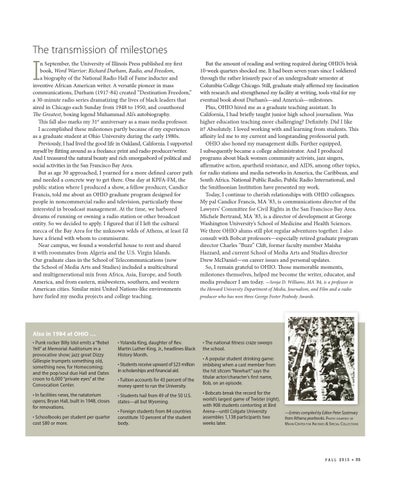The transmission of milestones
I
n September, the University of Illinois Press published my first book, Word Warrior: Richard Durham, Radio, and Freedom, a biography of the National Radio Hall of Fame inductee and inventive African American writer. A versatile pioneer in mass communications, Durham (1917-84) created “Destination Freedom,” a 30-minute radio series dramatizing the lives of black leaders that aired in Chicago each Sunday from 1948 to 1950, and coauthored The Greatest, boxing legend Muhammad Ali’s autobiography. This fall also marks my 31st anniversary as a mass media professor. I accomplished these milestones partly because of my experiences as a graduate student at Ohio University during the early 1980s. Previously, I had lived the good life in Oakland, California. I supported myself by flitting around as a freelance print and radio producer/writer. And I treasured the natural beauty and rich smorgasbord of political and social activities in the San Francisco Bay Area. But as age 30 approached, I yearned for a more defined career path and needed a concrete way to get there. One day at KPFA-FM, the public station where I produced a show, a fellow producer, Candice Francis, told me about an OHIO graduate program designed for people in noncommercial radio and television, particularly those interested in broadcast management. At the time, we harbored dreams of running or owning a radio station or other broadcast entity. So we decided to apply. I figured that if I left the cultural mecca of the Bay Area for the unknown wilds of Athens, at least I’d have a friend with whom to commiserate. Near campus, we found a wonderful house to rent and shared it with roommates from Algeria and the U.S. Virgin Islands. Our graduate class in the School of Telecommunications (now the School of Media Arts and Studies) included a multicultural and multigenerational mix from Africa, Asia, Europe, and South America, and from eastern, midwestern, southern, and western American cities. Similar mini United Nations-like environments have fueled my media projects and college teaching.
But the amount of reading and writing required during OHIO’s brisk 10-week quarters shocked me. It had been seven years since I soldiered through the rather leisurely pace of an undergraduate semester at Columbia College Chicago. Still, graduate study affirmed my fascination with research and strengthened my facility at writing, tools vital for my eventual book about Durham’s—and America’s—milestones. Plus, OHIO hired me as a graduate teaching assistant. In California, I had briefly taught junior high school journalism. Was higher education teaching more challenging? Definitely. Did I like it? Absolutely. I loved working with and learning from students. This affinity led me to my current and longstanding professorial path. OHIO also honed my management skills. Further equipped, I subsequently became a college administrator. And I produced programs about black women community activists, jazz singers, affirmative action, apartheid resistance, and AIDS, among other topics, for radio stations and media networks in America, the Caribbean, and South Africa. National Public Radio, Public Radio International, and the Smithsonian Institution have presented my work. Today, I continue to cherish relationships with OHIO colleagues. My pal Candice Francis, MA ’83, is communications director of the Lawyers’ Committee for Civil Rights in the San Francisco Bay Area. Michele Bertrand, MA ’83, is a director of development at George Washington University’s School of Medicine and Health Sciences. We three OHIO alums still plot regular adventures together. I also consult with Bobcat professors—especially retired graduate program director Charles “Buzz” Clift, former faculty member Maisha Hazzard, and current School of Media Arts and Studies director Drew McDaniel—on career issues and personal updates. So, I remain grateful to OHIO. Those memorable moments, milestones themselves, helped me become the writer, educator, and media producer I am today. —Sonja D. Williams, MA ’84, is a professor in the Howard University Department of Media, Journalism, and Film and a radio producer who has won three George Foster Peabody Awards.
Also in 1984 at OHIO … • Punk rocker Billy Idol emits a “Rebel Yell” at Memorial Auditorium in a provocative show; jazz great Dizzy Gillespie trumpets something old, something new, for Homecoming; and the pop/soul duo Hall and Oates croon to 6,000 “private eyes” at the Convocation Center.
• Yolanda King, daughter of Rev. Martin Luther King, Jr., headlines Black History Month.
• In facilities news, the natatorium opens; Bryan Hall, built in 1948, closes for renovations.
• Students hail from 49 of the 50 U.S. states—all but Wyoming.
• Schoolbooks per student per quarter cost $80 or more.
• Students receive upward of $23 million in scholarships and financial aid. • Tuition accounts for 43 percent of the money spent to run the University.
• Foreign students from 84 countries constitute 10 percent of the student body.
• The national fitness craze sweeps the school. • A popular student drinking game: imbibing when a cast member from the hit sitcom “Newhart” says the titular actor/character’s first name, Bob, on an episode. • Bobcats break the record for the world’s largest game of Twister (right), with 908 students contorting at Bird Arena—until Colgate University assembles 1,138 participants two weeks later.
—Entries compiled by Editor Peter Szatmary from Athena yearbooks. Photo courtesy of Mahn Center for Archives & Special Collections
fall 2015
• 35
